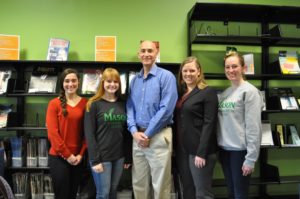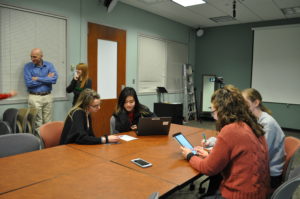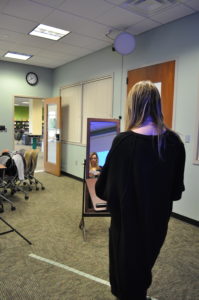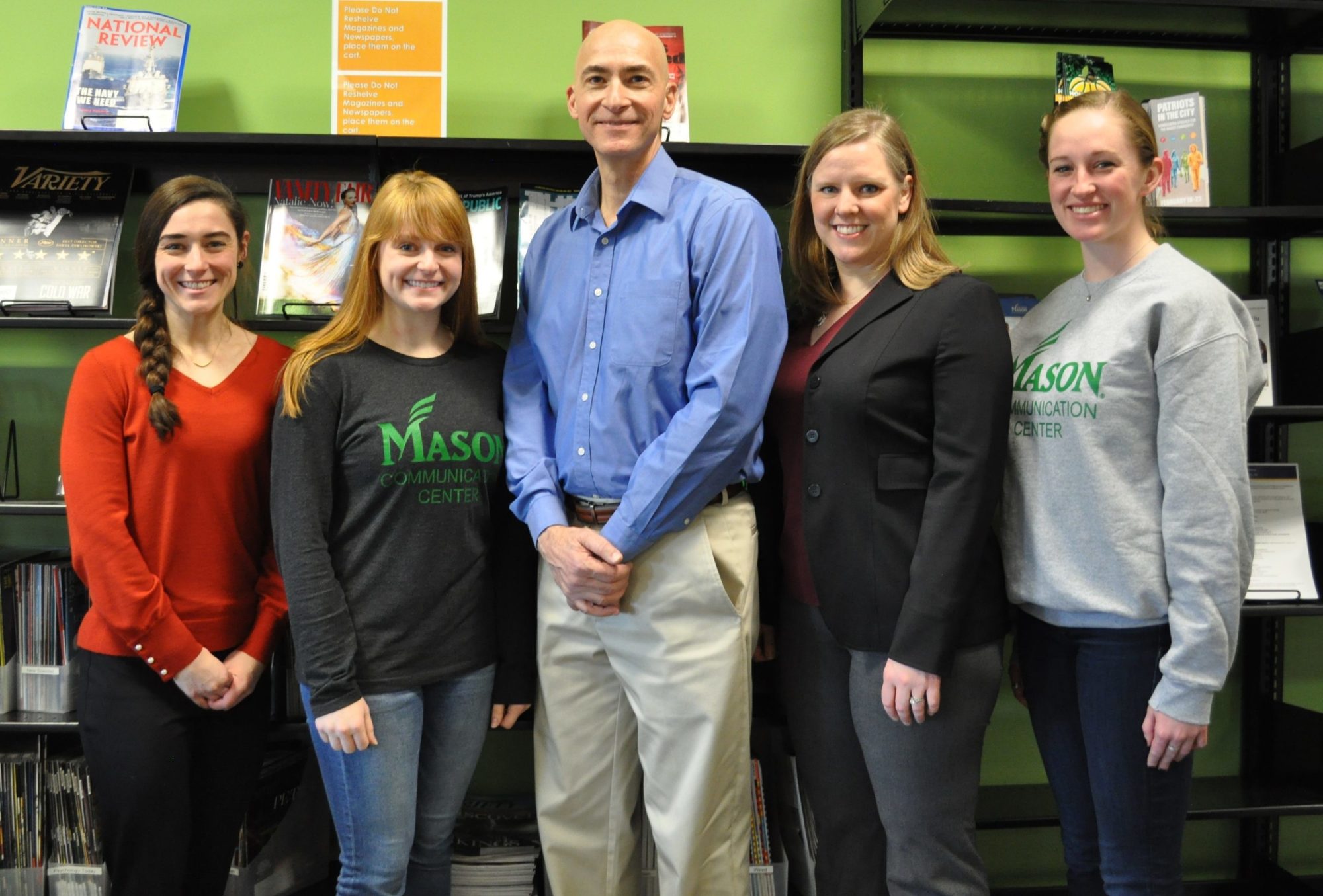The story of increasing enrollment resulting in new instructors, reductions in teaching space, and revisions in course structure: OR How a critical analysis of a Mason Core course created and confirmed a positive change for students
Several dilemmas were facing Mason’s COMM 100 and 101 courses:
- enrollment topping a record 4,000+ students
- an ever-changing and often novice set of 50-60 of instructors and the corresponding need to ensure teaching consistency and quality
- reduced classroom availability
- three different delivery methods, with no real data on what version was most successful
The question became how to wrestle these problems while maintaining and/or improving failure rates. While the process was pivotal, successful outcomes were vital.
Such was the concern for Dr. Melissa Broeckelman-Post, the Basic Communication Course Director, an Associate Professor in the Department of Communication and a Senior Scholar in the Center for the Advancement of Well-Being at Mason. She is responsible for planning, supervising, assessing, and improving the communication courses that meet the general education requirement at Mason.
Broeckelman-Post recognized she needed to put some serious analytical insight into best practices for this course — from materials and methodologies to delivery methods and student results. But how to pull off this important, yet complex, analysis while juggling an already full schedule?
The answer was found in a grant from 4-VA at Mason.

Armed with the financial support to hire a cadre of Ph.D. students to produce the “in the weeds” analysis, in one short year, Broeckelman-Post had both the necessary numbers and the path to developing and delivering a course that met the needs of the students and produced a blueprint for a pedagogical “win.” The research focused on pre- and post- course student surveys which considered communication apprehension, interpersonal communication competence, communication competence and engagement. Additionally, the analysis considered grades, attendance records, and a detailed review of more than 300 explanatory speeches, a required 5- to 7-minute presentation by all students. Four expert coders evaluated the presentations for five different elements – introduction, body, conclusion, overall impression and delivery.
Then, this analysis was applied to the two different delivery versions of the course: Face-to-Face and a fully online course, plus a pilot of a new version of the course which is based on a lecture/lab/speech lab format.
The results pointed to the newer version of the class.
In this version, Broeckelman-Post delivers an online media-rich introduction, with includes content overviews, readings, TED talks, model speeches, video analysis and pre-class activities. This not only assured a complete and thorough content delivery, it also saved precious classroom space. Last spring, this version was pilot tested in six sections of the course, and after seeing the results of this study, has been implemented for 100 sections this academic year.
The introduction is then followed by small group interactive face-to-face lab with discussions, interviews and group work presentations.
The bonus comes in the final element of the course that was added for the fall semester – individualized coaching sessions in the new  Communication Center for all students enrolled in the course. In the Communication Center, which is funded by the cost savings from moving the first hour of the course online, students meet with student Communication Coaches to get feedback on outlines, video record and practice presentations, practice interviews, work on developing group presentations, and more. Most of the Coaches are members of Mason’s nationally-renowned forensics and debate teams, graduate students who also teach the course, and students who have demonstrated outstanding communication and feedback skills, who are able to share their advanced training with students that are just getting started.
Communication Center for all students enrolled in the course. In the Communication Center, which is funded by the cost savings from moving the first hour of the course online, students meet with student Communication Coaches to get feedback on outlines, video record and practice presentations, practice interviews, work on developing group presentations, and more. Most of the Coaches are members of Mason’s nationally-renowned forensics and debate teams, graduate students who also teach the course, and students who have demonstrated outstanding communication and feedback skills, who are able to share their advanced training with students that are just getting started.
 The Communication Center is a ‘one stop shop’ for valuable one-on-one coaching sessions for students as they prepare presentations. Currently, the Center is open every day between 10:00 AM and 5:00 PM and books more than 300
The Communication Center is a ‘one stop shop’ for valuable one-on-one coaching sessions for students as they prepare presentations. Currently, the Center is open every day between 10:00 AM and 5:00 PM and books more than 300  appointments a week. It is anticipated that number will balloon as more students recognize the benefit of the help.
appointments a week. It is anticipated that number will balloon as more students recognize the benefit of the help.
“The bottom line of this effort is that we’ve produced a course pathway that provides the best possible outcomes for our undergraduate students, while supporting our instructors with a rich resource of teaching tools and techniques,” explains Broeckelman-Post. “What’s more, we’ve streamlined the course and saved some money, which we then were able to use to create our first-of-its-kind on-campus Communication Center. We are very proud that we were able to deliver this terrific outcome for all Mason students — thanks to our 4-VA grant!”
Communication Research and the Communication Center: It takes a team
Broeckelman-Post credits much of the success of this research project to the graduate student research team, which includes an ace crew of PhD candidates and a student earning her Masters. Katherine Hyatt Hawkins, Andie Malterud, and Anthony Arciero worked on the 4-VA grant, and Hyatt Hawkins and Briana Stewert are working on a subsequent research grant that is evaluating the added impact of the Communication Center.
Katherine Hyatt Hawkins is a third year PhD candidate in Communication who will graduate in May 2019. She studies health and instructional communication, and is currently managing the Communication, Health, and Relational Media (CHARM) Lab for the Communication department with Dr. Sojung Kim. Hyatt Hawkins served as the Basic Course Assistant and has helped to build the Communication Center. Hyatt Hawkins’ resume also includes internships at the Food and Drug Administration (FDA) and the National Cancer Institute (NCI).
Andie Malterud is a second year PhD student in Communication and is the Communication Center Coordinator. She also studies health and instructional communication and has served as the Basic Course Assistant. Malterud comes to Mason following her undergraduate and Masters work in South Dakota.
Anthony Arciero is now in his fourth year of a PhD program, with a specialization in Educational Psychology, and a secondary emphasis in Research Methodology. Arciero also works in the College of Education and Human Development in the Accreditation and External Reporting Office as a Graduate Research Assistant. He is a 22-year veteran of the Air Force, retiring as a Lieutenant Colonel.
Briana Stewart is a first year MA student in Communication and is the Assistant Communication Center Coordinator this year. She previously worked in the writing centers at Oakton High School and Christopher Newport University. Stewart and Malterud are currently working on a follow-up project funded by a Curriculum Impact Grant and Faculty Research Development Award to help evaluate the impact of the Communication Center.

